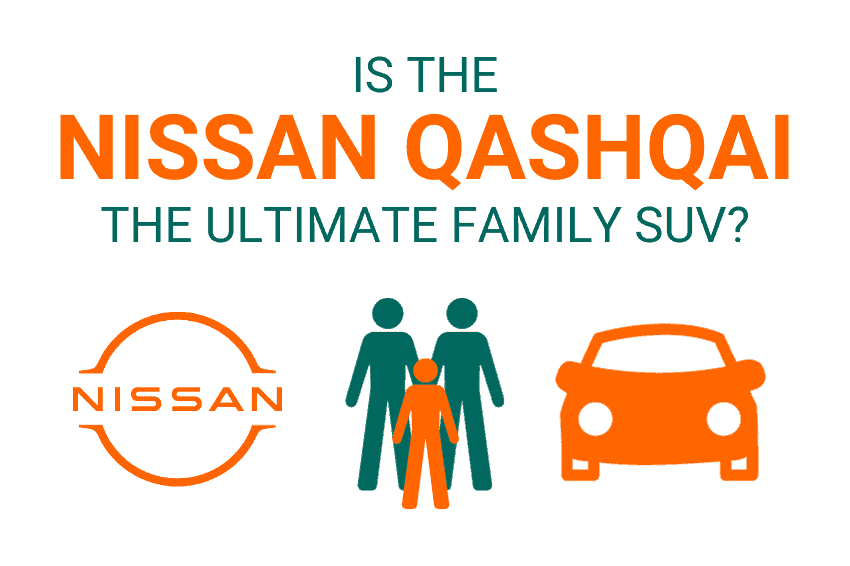- Watch Nissan Qashqai review
- What is the exterior design of the Nissan Qashqai like?
- What is the boot like?
- How does the interior of the Nissan Qashqai feel?
- What tech is on offer?
- What kind of engine does a Nissan Qashqai have?
- What is the Nissan Qashqai like on the road?
- Which Nissan Qashqai makes the best company car?
- Which Nissan Qashqai model is best?
- What is our verdict on the Nissan Qashqai?
Is it time for a new family SUV that’s stylish, spacious, and packed with safety tech? In our Nissan Qashqai review, we tackle the question: Is the new third-gen Nissan Qashqai your ideal family car?
The original Qashqai, introduced in 2006, set the trend with its sleek exterior, roomy interior, and elevated driving position. It inspired rivals like the Ford Kuga and Volkswagen Tiguan, shaping the SUV market.
Despite not having an electrified version, the Qashqai dominated the UK market in 2021, ranking as the best-selling SUV with over 30,000 registrations and the 7th best-selling vehicle overall.
It faces competition from electrified models like the Peugeot 3008 and Ford Puma, as well as premium alternatives like the BMW X1, Mercedes GLA, and Volvo XC40.
In this comprehensive Nissan Qashqai review, we’ll dive into the latest third-gen model, examining its evolution from its predecessor and determining if it’s the top choice for a family SUV today.
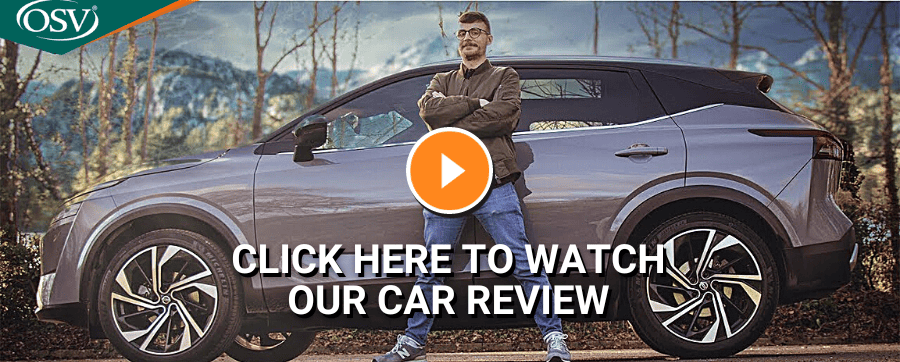
What is the exterior of the Nissan Qashqai like?
Let’s jump into the Nissan Qashqai review, starting with the facelifted front end. It’s bolder than the second-gen Qashqai, with striking LED headlights giving it a feline touch. The grille impressed us with its piano black trapezoidal design and chrome accents.
The massive bonnet and side crease lines add to its distinctive, powerful, and sleek appearance, making it stand out among family SUVs.
In our review, we chose Ceramic Gray paint, which we loved, and paired it with a contrasting pale black roof, one of the available two-tone options.
These cost around £1,145, and there are more choices, including metallic colours. Feel free to reach out to our team for further details on customization.

While the new Qashqai offers personalization, if you prefer the standard colour, it’s Flame Red, also seen on the Nissan Juke. These colours enhance the car’s design.
The crease lines continue along the side profile, leading to alloy wheels ranging from 17 to 20 inches. We opted for the top-tier “Tekna+” trim with 20-inch alloy wheels, which impressed us with their design. However, note that larger wheels can transmit more road imperfections, affecting the ride comfort. Keep this in mind when choosing your configuration.
Following those crease lines, let’s look at the door mirrors. These electronically folding mirrors are not only heated for those chilly mornings but also fully adjustable from the inside for your preferred angle.
They include a handy blind-spot monitoring feature, lighting up when a car passes closely and featuring indicator lights on the mirror’s end, adding a high-tech touch to the Qashqai.

We also appreciated the chrome inlay along the windows and colour-matched door handles. The chrome roof rail, while stylish, may not be the most practical feature.
On the bright side, there’s a beautiful glass sunroof that really enhances the cabin’s ambience and is a standout feature of the Qashqai. It adds a delightful touch of brightness and life to the interior.
Moving to the back, the Qashqai offers rear privacy glass, a shark-fin antenna, and a sporty rear spoiler—a nod to the crossover SUV trend. The rear light clusters merging around the tailgate add a nice touch, although the overall rear design is somewhat generic for a family SUV.
Despite the typical SUV appearance, the Qashqai maintains its identity, especially noticeable in the changed front end. The rear features a large privacy glass panel, Qashqai badging, and a silver-finished rear bumper.
What is the boot like?
The Nissan Qashqai now features an electronically operated tailgate, a first for this model, making it convenient for handling heavy shopping bags. While its boot space isn’t as generous as the Skoda Karoq or Volkswagen Tiguan, it still offers practicality.
The available space varies by trim level. Entry-level Visia and Acenta Premium trims provide 504L of boot capacity. However, higher-spec trims (N-Connecta, Tekna, and Tekna+) reduce it to 479L due to a height-adjustable boot floor.
While this lowers capacity, it’s a practical feature, and you can remove it for extra space, making it worthwhile, especially with the top-tier Tekna+ trim.
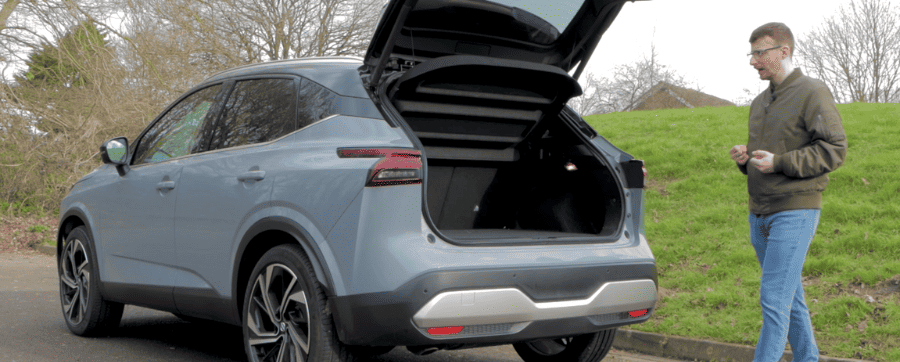
It’s worth noting that the Bose sound system, present in the top-spec model, occupies an additional 40L of space, which might disappoint those looking for maximum utility in the highest trim.
The Nissan Qashqai’s boot comes with practical features like a 12-volt socket on the right, a tethering hook on the left, hooks on the base for securing objects, and useful cubby holes for items prone to rolling.
To expand the boot capacity, simply fold down the rear seats; they’re spring-loaded for easy folding in a 60/40 arrangement. The height-adjustable boot floor, aligns with the seats, eliminating any floor gap. This SUV offers between 1379 and 1447L, depending on the variant.
For more details, including information on entry-level trims with extra boot space, reach out to OSV’s Vehicle Specialists at 01903 538835 or book a FREE consultation using the banner below, at your convenience.

What does the interior offer?
The latest Qashqai has transformed its once uninspiring interior into a smarter, more appealing space. Highlights include a premium leather steering wheel and dash with elegant stitching.
This attention to detail extends to the rear cabin, a rarity in affordable SUVs. The air conditioning unit, adorned with Piano Black buttons, complements the infotainment screen border.
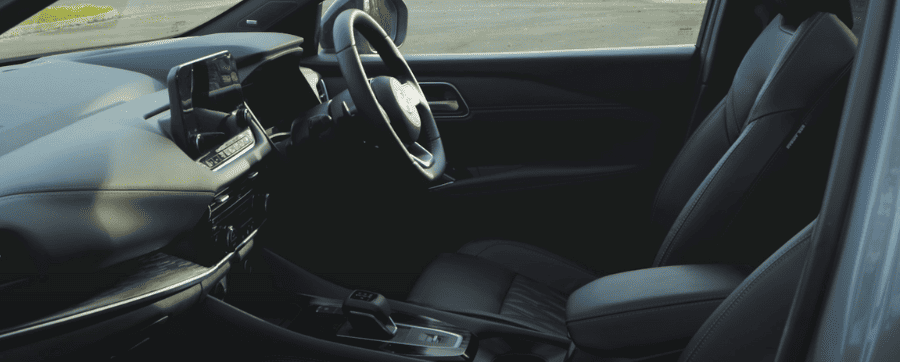
While some areas, like the dashboard and footwell, feature cheaper materials, the overall build quality is commendable, especially considering its affordability in the family SUV segment.
With five upholstery options available, the Qashqai offers a range of choices as you move up the trim levels.
The seats in the Qashqai offer excellent adjustability for finding your ideal driving position, allowing for a high vantage point on the road. Visibility is outstanding thanks to slender side pillars, reducing blind spots at junctions.
Models from “Tekna” upwards even feature electrically adjustable lumbar support. However, sitting all the way back can become uncomfortable on longer journeys due to an uncomfortable spot.
The front cabin is spacious, ensuring you won’t feel cramped beside your front passenger. The bulky centre console effectively separates the spaces without feeling confining.
The impressive glass sunroof floods the cabin with light when retracted, creating a calming atmosphere, making it a must-have feature in the Qashqai.
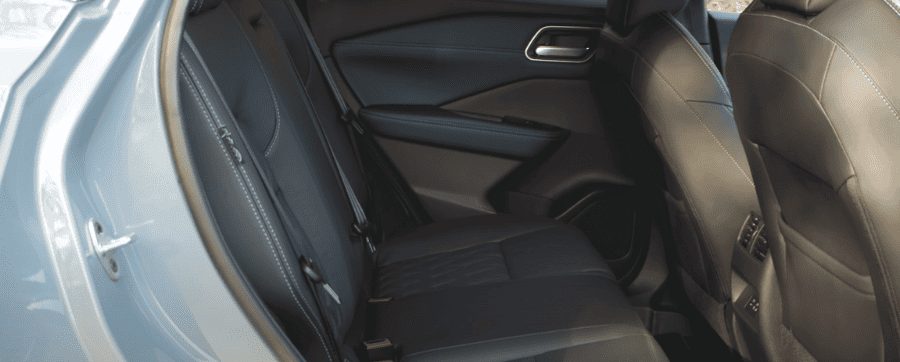
Moving to the rear cabin, the doors open nearly 90°, making it easy to install a child’s seat using Isofix fittings. The new Qashqai’s increased length creates ample headroom, even with the optional glass sunroof. Legroom is reasonable but depends on front seat positioning, and the supportive rear seats ensure comfort.
Backseat passengers have seat-back pockets for magazines or tablets. However, rear door bins are small and oddly shaped. The windows don’t fully wind down, a common feature in many modern vehicles.
While rear passengers share the front climate control, there are USB and USB-C ports for their convenience.
If there’s no middle passenger, the centre armrest offers cupholders but is somewhat uncomfortable due to the plastic design. The middle seat is tolerable for shorter journeys, but the transmission tunnel, while not massive, could be flatter for comfort and space optimization. Note that the middle seat is higher than the others.
What tech is on offer?
On the left of the steering wheel, you’ll find media controls for the infotainment system and a scroll wheel to navigate the driver display. On the right, there are cruise control settings, and paddle shifters, and even with an automatic transmission, you can switch to manual mode for on-the-fly gear changes.
The driver display is sharp and easy to read. It includes a rev counter on the left and a speedometer on the right, displaying speed limits, fuel levels, and basic info.
You can access various options, like a drive computer, tire pressure, compass, music controls (via Apple CarPlay), and customizable driver assistance features like blind-spot monitoring, forward collision warning, and lane keep assist. The display is 7 inches standard but upgrades to 12 inches from the Tekna trim onwards.
Additionally, higher-spec trim levels offer a 10.8-inch heads-up display, a favourite feature. It projects speed limits, your speed, and turn directions onto the road ahead, eliminating the need to look away from the road for crucial information.
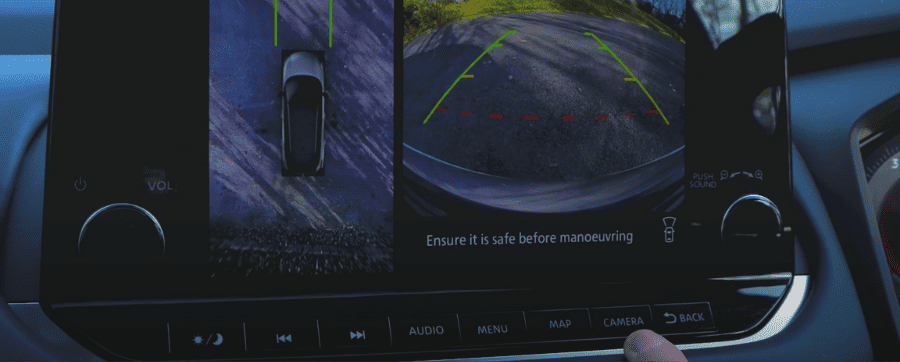
The media display, surprisingly smaller than the driver display, measures about 9 inches in the Tekna+ trim. Despite some critics, Nissan’s infotainment system has its merits.
It’s responsive, features sharp graphics, and large icons for quick glances while driving. Shortcut buttons at the bottom offer easy access to essential functions. Navigation is relatively speedy, and you can connect your smartphone through Apple CarPlay or Android Auto.
Other amenities include DAB radio and Bluetooth. With the top-tier “Tekna+” trim, you get the impressive Bose premium 10-speaker sound system.
Below the “Tekna+” centre console lies the neatly designed air conditioning cluster. It houses buttons for the heated steering wheel and seats, along with satisfyingly tactile controls for air conditioning intensity and temperature.
Further down, you’ll find a wireless charging pad, a 12-volt socket, and the start/stop button. The electronic parking brake, featuring an auto-hold function, is conveniently located for easy use.
However, the placement of the driving mode selector in front of the centre console might not be ideal for some, and there are a couple of cupholders between the seats.
Between the seats is a centre compartment with a handy tray for keys. Lift the tray, and it locks to the lid, revealing a deep compartment with USB-C and USB ports. The glove box, unfortunately, has limited space due to a fuse box on the left side. However, door bins are generously sized, providing good overall cabin storage.
Additional features in the Qashqai include an auto-dimming rear-view mirror to reduce glare from vehicles behind. Lighting controls are on the ceiling, along with the controls for the retractable glass sunroof. The interior is a significant improvement over the second-gen Qashqai.
If you’re considering it for your growing family or practical needs, feel free to explore your options with one of our Vehicle Specialists. Call us at 01903 538835 or click the banner below to schedule a chat with our experts; we’re here to assist you.

Visibility remains a standout feature in this Nissan Qashqai review, with a wide windscreen providing an excellent view of the road. Thin side pillars reduce blind spots at junctions and roundabouts, though slightly larger mirrors would have been a plus.
The rearview mirror offers fantastic visibility, but rear privacy glass can limit visibility when checking blind spots. Overall, the Qashqai excels in visibility, a key reason many choose it over rivals.
The Qashqai’s suspension offers a soft ride, particularly with 17 or 18-inch wheels, effectively absorbing pothole impacts. However, with 19 or 20-inch wheels, as in the Tekna+ trim, the ride becomes less comfortable, transmitting road imperfections into the cabin.
The larger wheels can also create a slight roar during acceleration on dual carriageways or motorways, but they provide a relaxing and comfortable cruise once at speed. Your choice of wheel size should align with your driving needs and conditions, considering factors like road quality and speed.
What kind of engine does a Nissan Qashqai have?
Under the hood, you have a choice of two 1.3-litre petrol mild hybrid powertrains. These mild hybrids use a small lithium-ion battery recharged through regenerative braking, capturing energy when you slow down.
You can select from two power outputs and pair it with either a six-speed manual or a CVT automatic transmission, which we chose.
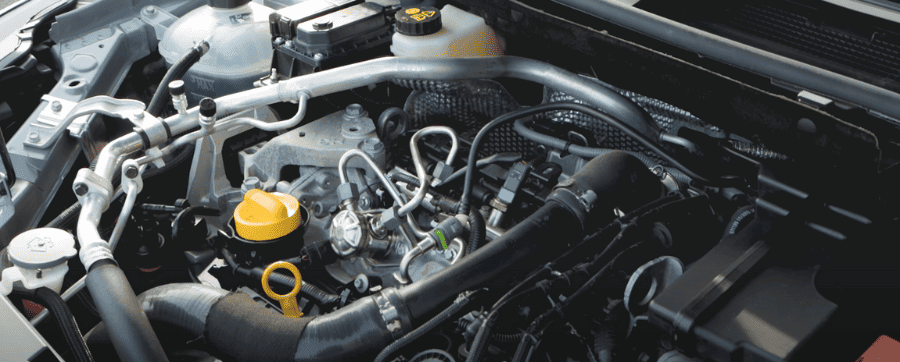
However, we found the CVT automatic experience less satisfying. Starting from a standstill can be jolty, making it a bit slow to accelerate, and requiring careful traffic judgment. Engaging the “Sport” mode helps for quicker overtaking on highways.
While not thrilling, the Qashqai prioritizes family-friendly practicality, which has made it popular in the UK. It offers comfort and style for your A-to-B journeys.
Standard models feature torsion beam rear suspension, but higher-spec versions with 20-inch wheels and all-wheel drive have a multi-link suspension setup. This improves body control, especially in tight turns, thanks to the sturdy side cushions that keep you securely in place despite some body roll.
What is the driving experience like?
The Qashqai’s steering is light, making it easy to navigate city streets, though the turning circle could be tighter for easier parking between cars. The panoramic view monitor and front/rear parking sensors, available with top-tier trims, provide helpful assistance when parking.
For safety, choosing the automatic transmission enables the ProPilot safety tech, including Navi-link, advanced autonomous cruise control that works in busy motorway traffic. This feature is exclusive to the CVT automatic.
If you opt for the manual, you’ll have adaptive cruise control and standard safety features like autonomous emergency braking and blind-spot monitoring. Nissan’s strong safety record means you can trust its safety features.
Which Nissan Qashqai makes the best company car?
The first available hybrid is the 1.3L DIG-T petrol mild hybrid, delivering 138bhp. It behaves similarly to the more potent powertrain but comes at a more affordable price point.
With a 0 to 62 time of 10.2 seconds, it’s respectable for a large SUV. The combined cycle offers a fuel efficiency of 44.7mpg, reducing your visits to the fuel station.
However, for company car considerations, this unit emits 143g/km of CO2, placing it in a higher benefit-in-kind tax band for 2022 to 2023. An option like the Nissan Leaf, which is fully electric with zero emissions, might be worth exploring for lower tax implications.
It’s important to note that the X-Tronic automatic gearbox is only available with the more powerful 156bhp unit, with the manual as a £1,600 saving over the automatic. The manual is fairly responsive.
With the more powerful unit, you can choose between two or four-wheel-drive, though the latter is exclusive to the automatic gearbox. The four-wheel-drive variant achieves 41.2mpg and may be suitable for towing needs, but CO2 emissions can rise to 156g/km, impacting company car considerations.
The two-wheel-drive variant offers three driving modes: “Eco,” optimizing fuel efficiency; “Standard”; and “Sport” for faster acceleration.
The four-wheel-drive variant adds “Snow” and “Off-Road” modes, useful for challenging conditions.
Nissan’s e-power technology uses a 1.5L petrol engine to generate electricity for a lithium-ion battery, powering electric motors on the front axle.
This technology, adapted from the all-electric Leaf, offers superior fuel efficiency and lower CO2 emissions compared to traditional combustion engines. The e-pedal technology, found in the Nissan Leaf, allows for regenerative braking to enhance fuel efficiency.
It’s a great option for those interested in some of the benefits of EV driving without range anxiety or charging infrastructure concerns. For more details, feel free to reach out to our Vehicle Specialists.

Which Nissan Qashqai model is best?
Let’s break down in this Nissan Qashqai review the different trims, including which could be the best for you.
Nissan Qashqai Visia
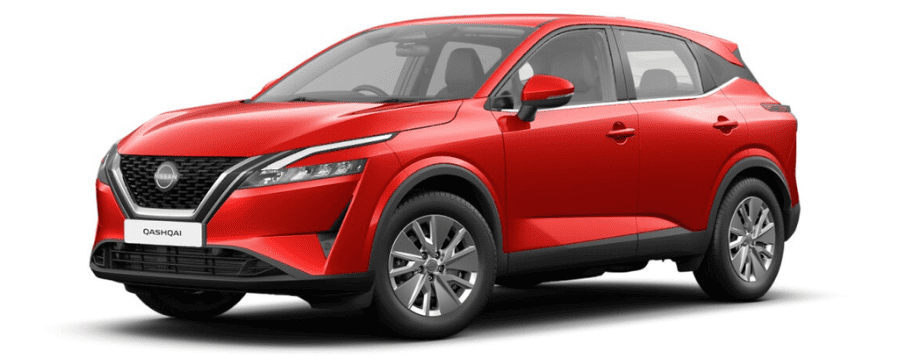
As for trim levels, the entry-level variant is “Visia” and prices start from £24,555. With this trim, you receive a whole host of standard equipment with the Nissan Qashqai.
However, the “Visia” trim includes a shark fin antenna, manual air conditioning, rear parking sensors, a seven-inch driver display behind the steering wheel, Bluetooth, the driving as mentioned above modes, and the smallest 17-inch steel wheels, which could be a benefit if you want your Qashqai to have a smooth ride quality.
Nissan Qashqai Acenta Premium
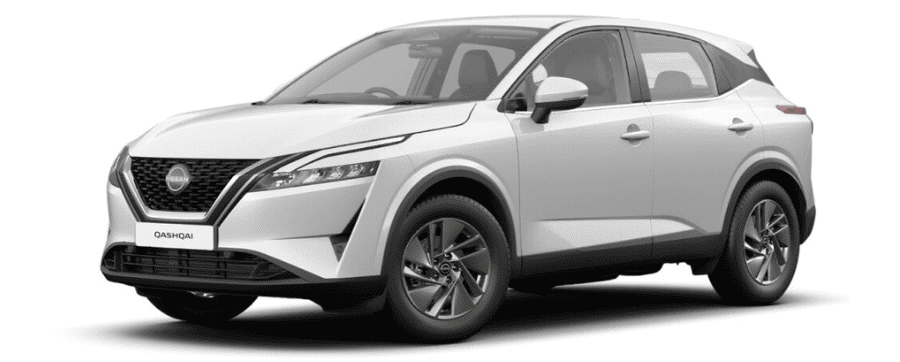
Next up the ladder is “Acenta Premium”, the second of five trims available. Prices start from £27,155 depending on whether you’ve gone for the six-speed manual or X-Tronic automatic transmission.
This variant adds auto-folding door mirrors, a two-way manually-adjustable lumbar support for the driver’s seat, a rear-view camera, Apple CarPlay and Android Auto, and an eight-inch media display in the centre console, meaning you have to go for this trim level to receive any kind of infotainment.
Nissan Qashqai N-Connecta
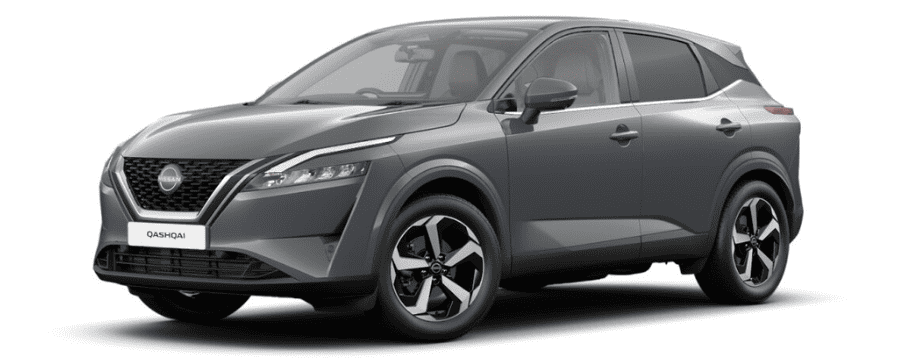
If you want even more tech, go with “N-Connecta“. Prices start from £29,190 and you get larger 18-inch alloy wheels and rear privacy glass.
In terms of tech, you get front parking sensors to complement the rear parking sensors, and around view 360° monitor (which makes parking a breeze), you also get a larger nine-inch media display integrated with the NissanConnect services.
Nissan Qashqai Tekna
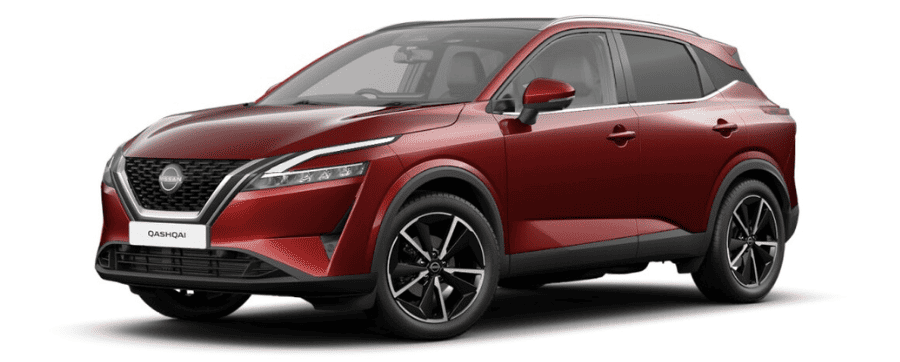
At the top of the range is the “Tekna” trim, starting at £31,865. For an extra £2,675, you get valuable additions: an eight-way electric driver’s seat adjustment, a wireless charging pad, and a power tailgate for convenience.
Tech-wise, there’s a 10.8-inch heads-up display, a larger 12.3-inch driver display, and the heat pack with heated front seats, steering wheel, and windscreen for chilly mornings.
Styling enhancements include 19-inch alloy wheels, ambient lighting, a glass roof with roof rails, and the option for a premium Bose sound system. “Tekna” is our standout trim, offering comprehensive tech at a competitive price compared to rivals.
Nissan Qashqai Tekna+
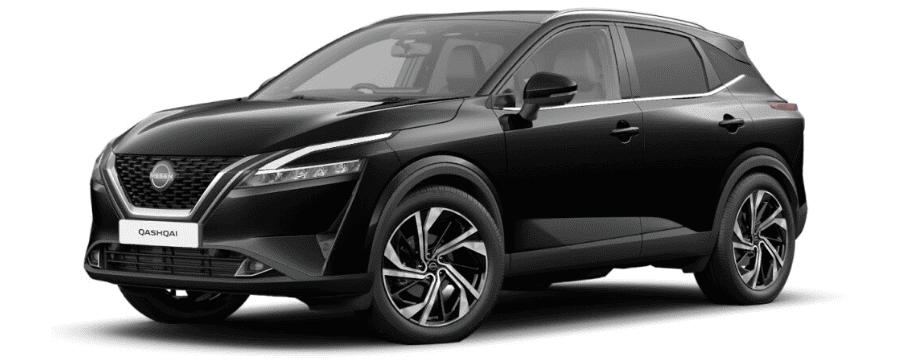
The highest-spec trim level is “Tekna+” and this starts from £35,195, which is quite a significant premium over the previous “Tekna” trim. Unfortunately, it doesn’t justify those extra costs in our opinion.
With this trim, you get the premium Bose sound system as standard and the biggest selling point is the larger 20-inch alloys.
You also get full weight adjustment for the lumbar support and quilted premium leather seat fronts, but is all this worth an additional thousand pounds? We don’t personally think so, but we’ll leave it up to you.
If you want to maximize your specification as much as possible then opt for “Tekna+” and you will benefit from everything previously mentioned.
Nissan doesn’t make it that easy to understand the different trims, so if you’d like to dive into these in a bit more detail, and chat through your options with one of our Vehicle Specialists, we’d be more than happy to find your perfect variant. Please get in touch on 01903 538835 or just click the banner below to book a date or time that works best for you for a quick chat.

Nissan Qashqai review: Should you buy, lease, or finance the new Nissan Qashqai?
As we come to the end of this Nissan Qashqai review, let’s evaluate what we’ve covered so far. The Nissan Qashqai has several compelling reasons to consider. Its elevated driving position provides an excellent view of the road, offering the same advantage it’s known for in the small SUV segment.
It excels in comfort, especially during cruising, providing a smooth and relaxing ride. Inside, you’ll find premium materials and improved tech, creating an intuitive and functional interior.
The safety features are impressive, and higher-spec trims offer excellent practicality, including a height-adjustable boot floor. While this feature impacts overall boot space, you can expand it by folding down the rear seats, making it ideal for family outings or accommodating bikes.
On the downside, the Nissan Qashqai may not excite those seeking a punchy performance; it offers a smooth and relaxing drive instead, emphasizing family-friendly practicality in this review.
The automatic CVT transmission, while smooth, has occasional gear change sensations and starting jolts that could have been refined. With larger wheels on the highest-spec trims, road imperfections are more noticeable, potentially causing discomfort.
Despite these minor drawbacks, the Qashqai is an excellent choice for growing families. If you’re considering it, explore our latest offers on the Nissan Qashqai and connect with our Vehicle Specialists at OSV for personalized advice. Visit our YouTube channel for official OSV Car Reviews, including the Nissan Qashqai review, or read our written car reviews if you’re still exploring your options.

